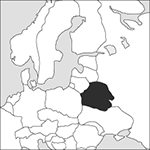
Source: MAPS IN MINUTES™ © RH Publications (1997)
Capital:
Minsk
Area:
207,600 sq km (80,134 sq miles)
Population:
9,625,888 (2012 est)
Currency:
1 rouble = 100 kopeks
Religions:
Eastern Orthodox Church 80%; Roman Catholic, Protestant, Jewish, and Muslim minorities
Ethnic Groups:
Belorussian 83.7%; Russian 8.3%; Polish 3.1%
Languages:
Belorussian (official); Russian (official); minority languages
International Organizations:
UN; Commonwealth of Independent States; OSCE; Euro-Atlantic Partnership Council; Non-Aligned Movement
A landlocked country in eastern Europe, formerly a constituent republic of the Soviet Union. It is bounded on the west by Poland, on the north-west by Latvia and Lithuania, on the north and east by Russia, and on the south by Ukraine.
Physical
Gentle hills run through a series of low plains which are forested with conifer, oak, lime, and ash. Many rivers drain the land into the vast area of the Pripet Marshes.
Economy
Under the Soviet Union most industry in Belarus was dependent on processing raw materials from other parts of the country and after independence the country’s inability to pay market prices for supplies led to severe recession. In 1994 Belarus entered into monetary union with Russia, which enabled it to obtain cheap Russian raw materials, and Russian control of Belarus’s economy has continued to grow. Principal industries include oil refining and the manufacture of machinery, vehicles, and consumer goods. An important export is refined oil; cruide oil is imported from Russia, but, since 2006, Russian price subsidies have been withdrawn, making the trade much less lucrative for Belarus.
History
Belarus (once referred to as White Russia) had been part of Lithuania and later Poland until conquered by Russia under Catherine the Great. Heavy fighting took place during and after World War I, before the Treaty of Riga (1921) which divided the area between Poland and the newly declared Soviet Socialist Republic of Belorussia, which joined the Soviet Union. In 1939 the latter occupied all the area as far as the River Bug, and heavy fighting took place after the German invasion in 1941. In 1945 the Belorussian SSR was granted a seat in the UN National Assembly, and Poland abandoned its claim to western Belorussia, its Polish population being transferred to Poland. The rich steppe lands in the south of the republic suffered heavy pollution from the Chernobyl disaster of 1986. In April 1991 the Belorussian SSR declared its independence from the Soviet Union, renaming itself the Republic of Belarus. Multiparty politics were adopted, but the communists have continued to dominate politics and the centrally planned economy has been maintained. A presidential constitution was adopted in 1994 and Alexander Lukashenko (1954– ) was elected President later that year. In four referendums in 1995 Belarussians voted in favour of establishing even greater political, economic, and cultural links with Russia than had existed during the Soviet era. A union treaty establishing joint economic, foreign, and defence policies between the two countries was signed in 1996 and further areas of cooperation were agreed in subsequent years. Also in 1996, Lukashenko greatly increased the President’s powers, his plans being opposed by parliament but supported in a referendum. He was re-elected in 2001, 2006, 2010, and 2015 in polls widely regarded as flawed. His dictatorial style of government and Belarus’s poor record on human rights led to strained relations with other European countries. A foreign-exchange crisis in 2011 required large international loans, mainly from Russia, to stabilize the economy.
- signal transducer and activator of transcription
- signal transduction
- signal winding
- signature
- signature analysis
- signature biometrics
- signature file
- signature of space–time
- signature scanning
- sign bit
- sign convention
- homobaric leaf anatomy
- homocercal tail
- homocline
- homocyclic
- homodont
- homodyne receiver
- homo economicus
- homoeomereity
- homoeostasis
- homogametic sex
- homogamy
- homogeneity
- homogeneous
- homogeneous accretion